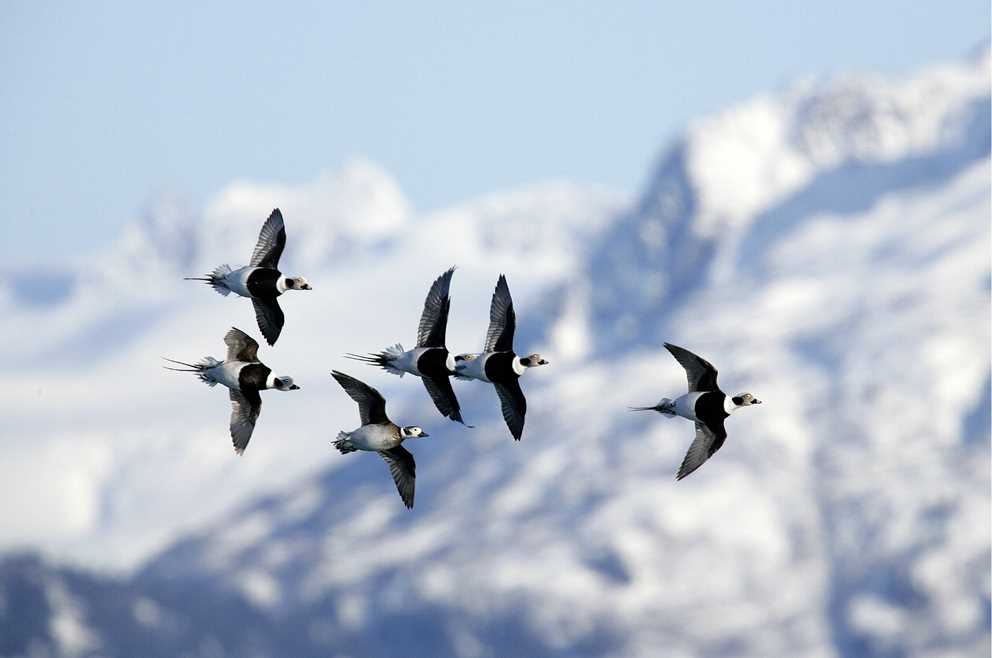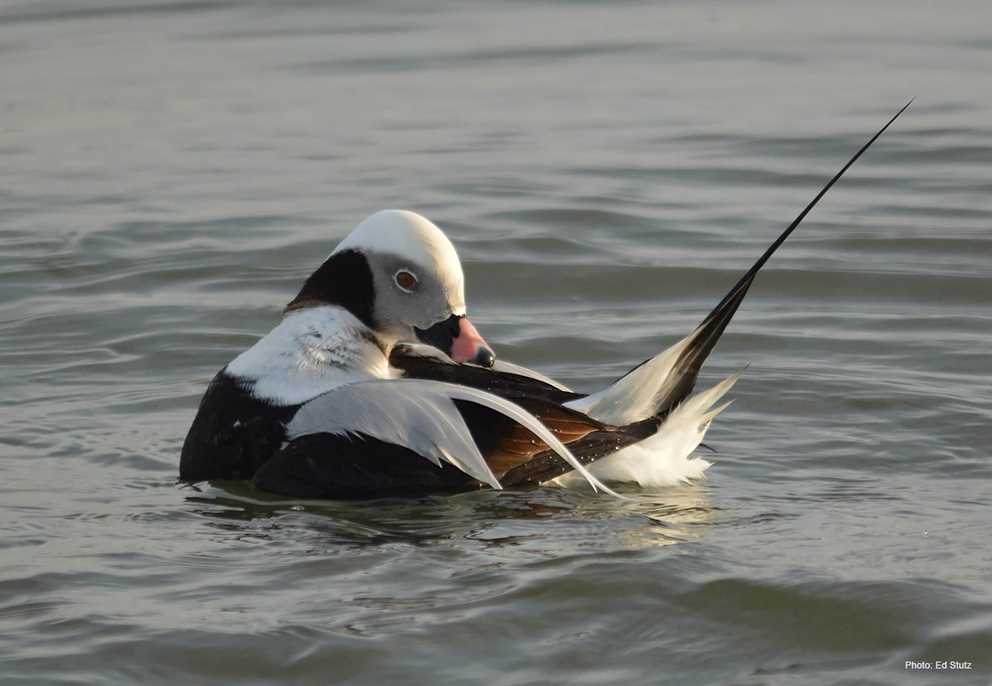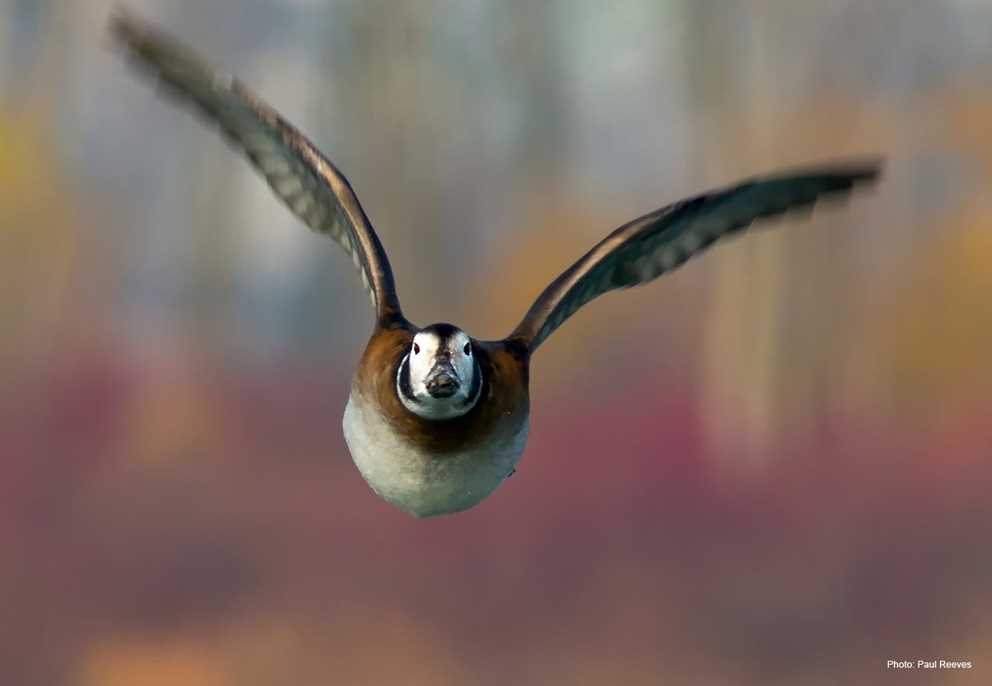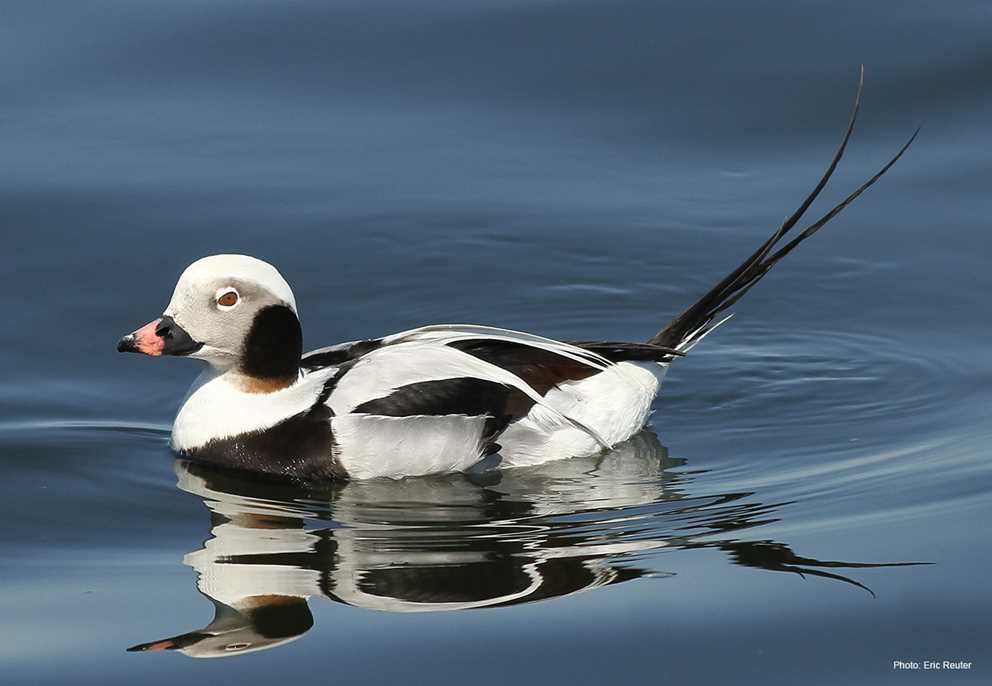Overview
The Long-tailed Duck is a medium-sized sea duck with a circumpolar range. In North America, they range from Alaska across the Canadian Arctic, including many Arctic Islands, with some occurring as far north as 80°N latitude. Breeding habitats are tundra lakes and wetlands. In migration and winter, they inhabit nearshore marine areas, from the Aleutia south the Baja, and Newfoundland south to Florida and the Gulf Coast, and the Great Lakes. Uncommon on inland lakes and rivers in winter.
Unique among waterfowl, Long-tailed Ducks exhibit three plumages annually, contributing to their complex seasonal appearance. They are most often observed in wintering areas, where males display striking white plumage with dark ear patches and elongated tail feathers, while females are deep brown with white facial markings
Description
Key Identification Features
- In flight, they typically fly low across the water, with flocks twisting and turning in loose formations.
- In winter, males have a white head with a grayish bill with a notable pinkish saddle. The neck, belly and long tertials are white. The breast and back are black, but long white tertials often cover the back. Males have long black central tail feathers.
- Females are mostly deep brown or blackish, with a white face contrasting with deep brown crown and ear coverts, brown coverts, a white belly and flanks, and lack the long tail of males.
Male/Female Average Length and Weight
- Weight: Males 1.3–2.4 lbs.; Females 1.1–2.1 lbs.
- Wingspan: Males 7.5–9.5 in.; Females 7.2–8.4 in.
Male Identification
- Three molts annually for adults—the pre-alternate molt, and pre-basic molt and supplemental molt, which is unique among waterfowl in North America.
- Alternate (Breeding) Plumage: The head and neck are white, with gray extending back around the eye with a black ear patch, a deep brown breast, back, rump and tail, and a white belly and vent. They have long gray to white scapulars that cover the dark back plumage. The bill is grayish with a pink saddle and a gray nail.
- Basic Plumage: The head and neck are black, with a gray patch around the eye. The back has wide long feathers and scapulars that are black in the middle and brown on the edges. The bill is dark with a yellowish tip.
- Supplemental Plumage: The head and neck are white with a poorly defined gray patch on the lower cheek, the back feathers appear buffy tan with black centers. The bill is pale gray. Some elements of basic plumage retained.
Female Identification
- Alternate (Breeding) Plumage: Variable, ranging from brownish gray to gray, with a large deep brown patch on the lower cheek, the back is chestnut to dark gray, while the breast is brown, and the sides and flanks are white.
- Basic Plumage: The head and neck are brownish black, with a light brown to gray patch around eye extending back to neck. The flanks and belly are white and the back has black and brown feathers with gray margins. The bill is grayish with a pale yellowish-gray saddle.
- Supplemental Plumage: The back has short, rounded feathers, with buff, gray, or tawny margins. The head may show whiter plumage versus basic, with some basic plumage retained.
In-Flight Identification
- Male/Female: Both sexes show dark wings in flight.
Vocalizations
Very vocal, especially in breeding season, but also in winter.
- Male Calls: Male call describe variously as “ahr-ahr-ahroulit” mainly given in courtship.
- Both sexes give “gut-gut” call while feeding, or as contact call.
Similar Species
- Female Harlequin: Long-tailed Ducks are unlikely to be confused with any other species, but females could be confused with female Harlequin Ducks. Female Long-tailed Ducks have light bellies and flanks, whereas female Harlequin Ducks have brown flanks.
Habitat Preferences
- Breeding: Long-tailed Ducks are typically found on freshwater tundra lakes and wetlands.
- Migration and Wintering: In migration and winter, Long-tailed Ducks use nearshore marine habitats of the Pacific Coast from the Aleutian Islands to Oregon, and on the Atlantic Coast from Newfoundland and Labrador south to Virginia, and in the Great Lakes. Regular but less common further south on both coasts and the Gulf of Mexico. Uncommon to rare inland except on the Great Lakes.
Foraging Habits and Diet
- Long-tailed Ducks are capable of diving to at least 240 feet and forage extensively on invertebrates throughout the annual cycle.
- Breeding Season: During spring and summer, they ingest various species of aquatic insects and crustaceans, fish roe, and some vegetation.
- Winter and Migration: In winter they consume a wide range of invertebrates, especially crustaceans, bivalves, fish, and fish eggs.
Breeding Habits
- Monogamy: Long-tailed Ducks are believed to have serial or long-term monogamous mating systems, but information is lacking.
- Nest Locations: Nest in association with tundra lakes and wetlands with nest sites in grass clumps or dense shrubby cover, usually near water.
- Clutch Size: Typically, 6 to 9 eggs. The eggs are sub-elliptical to oval, pale gray to olive-buff, and are 2.1 by 1.4 in. The incubation period is 24–29 days. Given their Arctic breeding range and late nest initiation dates, they are not known to renest.
Migration and Distribution
- Fall Migration: Long-tailed Ducks depart breeding wetlands in June–July (males, unsuccessful females) or July–August (successful females). May have molt migrations to molting areas, then depart for wintering areas in August. Late migrant, arriving in Great Lakes in October, and coastal areas in late November and December.
- Spring Migration: Spring migration March–April with arrival on breeding areas in May or early June.
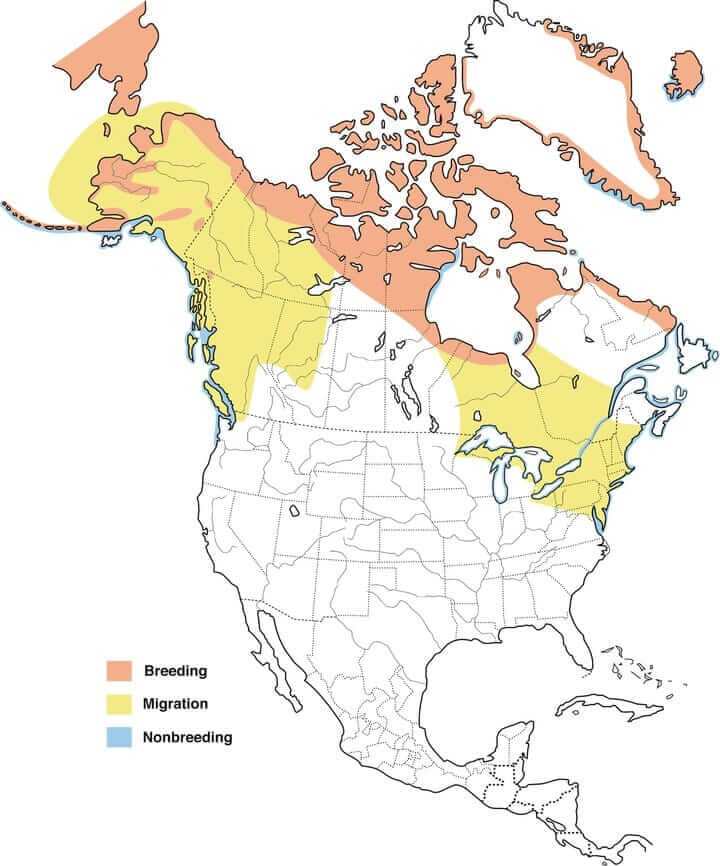
Conservation Status
- IUCN Status: Vulnerable
- Population Status: The North American population estimate suggests 1 million birds, of which 200,000 breed in Alaska, and the remainder in Arctic Canada. Data supporting estimates are poor and estimation difficult given Arctic breeding range and coastal wintering areas. Limited data suggests that the populations have declined 80% since the 1950s, but the cause(s) and rates of declines are poorly understood. The population is believed to have been stable since the 1990s.
- Conservation Concerns: Main threats to the population are oil spills, incidental kill in fishing nets, and contaminants.
- Conservation Focus: Conservation efforts focus on monitoring their population (including aerial surveys), protecting available habitat, mitigating the effects of climate change, and reducing their chance of getting entangled in fishing equipment.
Harvest Information
- An average of 31,515 Long-tailed Ducks were harvested annually in the US during the 2019–2022 hunting seasons.
- The harvest of Long-tailed Ducks is typically highest in the Atlantic Flyway, accounting for 50 to 60 percent of the total US harvest.
- The top three states for Long-tailed Duck harvest, based on annual averages across the 2019–2022 hunting seasons, were Michigan (8,447), New York (5,792), and Maryland (5,755).
